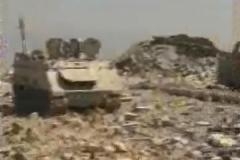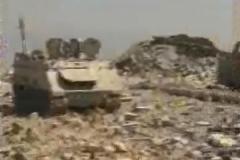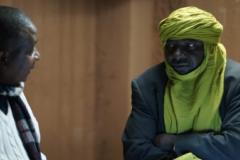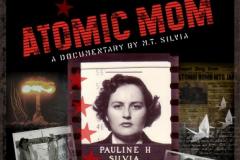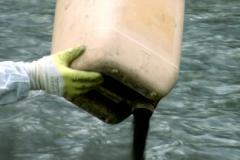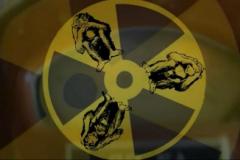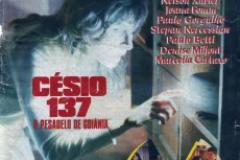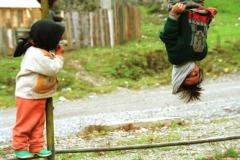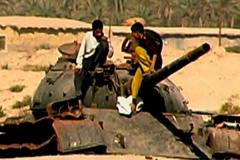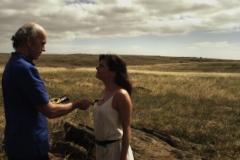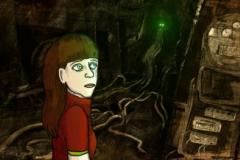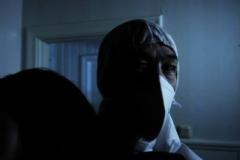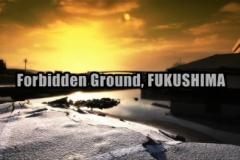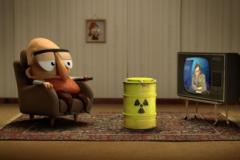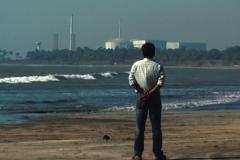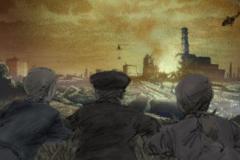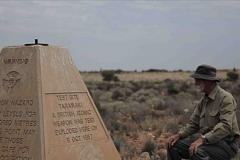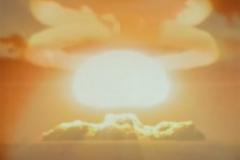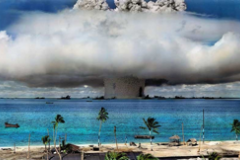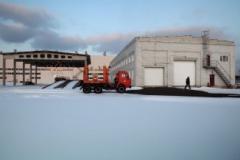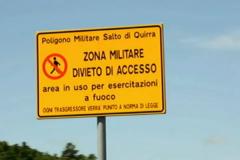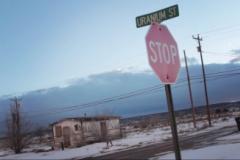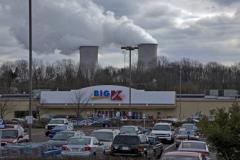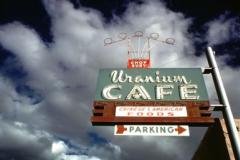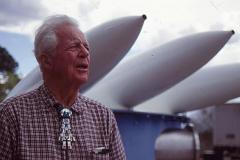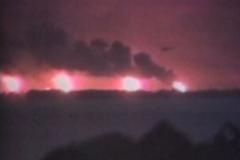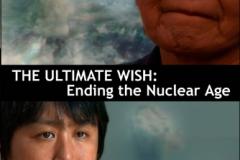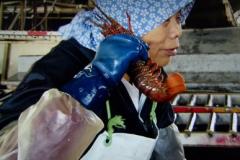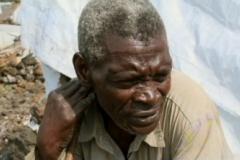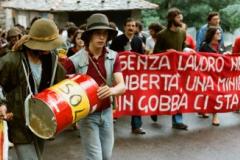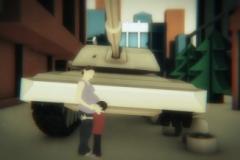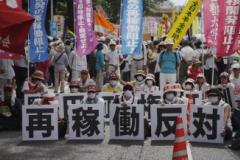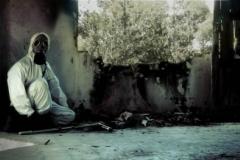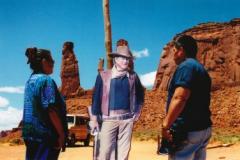MUNICH, BAMBERG & BERLIN

MUNICH 2013 - SEPTEMBER 26TH TO 29TH, 2013
Program - download PDF
Festival-Flyer - download
Festival-Poster - download
Report Uranium Film Festival 2013 - download
Filmtheatres:
Rio Filmpalast
|
Rosenheimer Straße 46 Normal price: 8,50 € |
Werkstattkino Fraunhoferstr. 9 5, - € for all |
Germany, 2012, 4 min, no dialogue
Animation
World Premiere
Animated short film about Fukushima children who can't play outside. About their dreams and realities.
Bachelor in 2012 of Shoko Hara and Paul Brenner
Sound design and Music: Lorenz Schimpf
Teachers: Prof. Klaus Birk, Alexander Hanowski, Martin Hesselmeier
DHBW Ravensburg, Studiengang Mediendesign
Director Paul Brenner present, Munich 2013
Italien, 2006, 22 min, Englisch
Produktion Rainews24
Krieg im Libanon und seine Folgen. Italienische Reporter gehen der Frage nach: Hat die israelische Armee Uran-Waffen eingesetzt?
(Anatomia di una Bomba)
Directors: Angelo Saso and Maurizio Torrealta
Italy, 2006, 22 min, English
Production Rainews24
The Israeli army denied the use of uranium-based weapons in Lebanon. So, how can people defend themselves from potential uranium-related harm? What precautions will the Unifil troops in the area take, and what kind of testing has been carried out to prevent the risks? The documentary directly covers those questions.
Germany, 2013, 90 min, German
Documentary
The film reveals the hidden agenda of the nuclear industry in Africa and the alarming consequences for people and the environment. In collusion with corrupt governments and questionable business partners energy companies source uranium for their domestic markets. And – faced with an apparent "sales problem" of nuclear technology in the Western world – they also lobby African governments to buy nuclear power plants.
Otherwise well informed high-level decision makers in Africa seem oblivious to the risks of nuclear power. They happily welcome the prospect of a seemingly endless, cheap and clean energy source. And their national pride is fuelled by the fact that the radioactive raw material for the new reactors doesn't need to be imported from other countries – it's hidden in the African soil.
Anti-nuclear activists in Africa are intimidated, persecuted and sometimes killed. In this film, critics of the nuclear industry speak out against the injustice and reveal the dubious activities of nuclear enterprises - from the illegal exploitation of the mines in the Congo to the controversial mining operations in the Sahara region. We travel through the desert on the "Uranium Highway" and show how the current war in Mali is related to fifty years of uranium mining that have destroyed people's livelihoods and pushed them into the hands of Al-Qaeda terrorists.
The film shows the dilemma of the African continent: It desperately needs cheap and reliable electric power for its development - but instead of being able to use its own resources, Africa is forced to sell off its riches to corrupt multinational enterprises. The sobering conclusion: In the future, African governments will need to give up their unrealistic nuclear ambitions and develop appropriate technologies to free themselves from their technological dependence on Western enterprises.
Filmwebsite: www.a-o-buero.de/en/films/filme/datum/2013/05/31/atomic-africa/
(Atomny Ivan)
Russia, 2012, 91 min, Russian, English subtitles
Production: Telesto Film Company
Romantic Comedy
That is a plane story of people from the future which is getting to be real nowadays. The heroes are beautiful and helpless, but they continue to fight for their own happiness and purport. The story takes place in the town where the nuclear engineer may live in one apartment with his mother, the nuclear engineer and his grand-mother – the pioneer of nuclear industry. The story is really outstanding, it is about Ivan and Tania, Tania is interested in her science carrier and Ivan is not interested in anything, but Tania. The new third hero makes heroes to wake up. A lyrical comedy.
Producer Victoria Gromik present, Munich 2013
Japan/USA, 2010, 80 min, English, English subtitles
Documentary
Atomic Mom weaves an intimate portrait of a complex mother-daughter relationship within an obscure moment in American history. Pauline Silvia, the filmmaker's mother, undergoes a crisis of conscience about her work in the military during the early 1950's Atomic Testing Program.
The film follows these mothers, each on a different end of atomic warfare, as they attempt to understand the other.
Spain, 2012, 4 min
About the relationship among radioactive pollution in water and food safety.
Brazil, 1989, 95 min, Portuguese, English subtitles
Producer: Laura Pires
Doc Fiction
AUDIENCE AWARD BEST FEATURE FILM 2011
In the ruins of a demolished hospital for cancer treatment in the centre of the Brazilian city Goiânia, two young men found an old "forgotten" Teletherapy Unit, which contained a highly radioactive "Caesium 137 bomb". They sold it to a local scrap metal dealer, who opened that Pandora's box. People were fascinated by the dazzling blue light of the caesium crystals. But they did not know, that it was the shine of the death. Hundreds if not thousands of the citizens and visitors of Goiânia became victims of Caesium 137. The script of the movie is based on statements by the victims and medical personal attending the victims, taken by Roberto Pires at the time of the accident.
Romania, 2009, 64 min, English subtitles
Production: Libra Film Productions
Special Achievement Award 2013
In 1950, the Russians discovered a rich uranium deposit in Apuseni Mountains, Romania. Shortly thereafter they developed a small city nearby and proceeded with the massive exploitation of the ore. The main objective: support of the Soviet military nuclear program. Almost two thousand Romanian miners were working day and night, around the clock, in four shifts. There was no concern for the labor or environmental protection. Most of the mine's employees didn't even know they were extracting uranium, but quartz. Now, in the former miner colony Baita Plai there are still 90 people living. A small and poor community in a place that seems devastated by an atomic bombing. Even though in february 2009 the uranium mine was officially decommissioned and the entire area entered in a environmental program, as an irony of the faith, the uranium comes back home as radioactive waste. By a Government decision, some galleries of the former uranium mine from Baita Plai were transformed into the National Radioactive Waste Storage.
Estonia, 2012, 14 min, without dialog
Comedy Thriller
Producer: Tallinn University Baltic Film and Media School; Estonian Academy of Arts
"What would happen if I gave some of my dad's nuclear liquids to my pet rat?" the kid thought as he poured some uranium into his rat's bowl. BANG!! Curiosity Kills is a splatter comedy about a radioactive killer rat.
(Todesstaub – die verstrahlten Kinder von Basra)
Germany, 2010, 29 min
Documentary
The German physician and scientist, Dr. Siegwart Horst Günther, was the first one to draw public attention to the terrible long-term consequences of uranium bullets and bombs after the first Gulf War in 1991.
After the Film:
Discussion & Round Table with ICBUW-Germany.
Guest: Prof. Peter Horn (IAEA expert), Dr. Winfried Eisenberg (IPPNW), Prof. Manfred Mohr (ICBUW), Doug Weir (ICBUW) - Claus Biegert moderation.
Australia, 2012, 87 min, English
Producer: Tom Young
Science fiction
World Premiere
In the not too distant future, the newly formed Independent Republic of South Australia is the phoenix that rises from the ashes of a decaying and corrupt Australian Commonwealth, becoming wealthy beyond imagination on the back of uranium. However, the real power lies with Double Happiness Uranium, a massive global energy corporation secretly developing the ultimate weapon, a neutron bomb that targets the biological cells of select individuals.
Spain, 2011, 13 min, English
Fiction
A man breaks into an apartment carrying a big black backpack. He is wearing an anti radiation suit. The place looks abandoned the radiation levels are crazy high. Then he looks around and starts searching for things to steal. Soon he will realize he is not alone.
What happens inside an exclusion zone where no one is supposed to be? Is there any people left? If that's the case, are they suffering? This short is meant to answer all those questions.
Germany, 2013, 10 min, English
World Premiere
Behind the power outlet in her room the little girl discovers a futuristic fairground run by the nuclear energy industry. Soon her fascination turns into horror. There is no way back, the catastrophe is near. The Fukushima nuclear accident is blueprint for the story: a society, confronted with the sudden disaster, acting like headless chicken - those responsible send their apologies.
Realisation: Ilinca Höpfner, Helge Henning
Narrator: Nick Cave
Soundediting: Sid Gautama
Producer: Ingmar Böschen
Germany 2013
Sweden, 2011, 14 min 30, Swedish/English Subtitle
Latin American and Indian Premiere
Yellow Oscar Best Short Film 2012
During a coffee break two men, wearing protective suits, are having a conversation about Chernobyl, Harrisburg, Forsmark and nuclear meltdowns.
Back at work their lack of empathy makes them true professionals.
And someone else becomes a victim. Coffee Break is a comedy-thriller.
Japan, 2012, 57 min, Japanese, English subtitles
Documentary
World Premiere
It is a documentary on the aftermath of the disaster in Fukushima.
Someone said "Fukushima, it's like a parallel world". It's another world. Apparently, from the outside, everything looks normal. Outside the exclusion zone of 20km, life continues as before, but not quite, this is only an appearance. The danger is invisible. My challenge is: how to make visible what is invisible.
(Halbwertszeit)
Germany, 2012, 20min, English subtitles
Production: Bauhaus-University Weimar
Science fiction
In the year 2022: After a serious meltdown in a German nuclear power plant the soil is contaminated and people live in constant threat of radioactive fallout. Low radiation vegetables are so precious that they can be proffered only in fine restaurants. Those can be ordered by the mysterious "Black Card".
So imagine how satirically: A story of a future where the food comes before morality.
(Herr Hoppe und der Atommüll)
Germany, 2011, 4 min
Producer Filmakademie Baden – Württemberg
Animation
A barrel of nuclear waste drops into the living room of Herr Hoppe an average suburbian German. He has to get rid of it and does it in his own wacky way.
USA, 2012, 54 min, English
Documentary with animation
This film is inspired to bring awareness to the Hiroshima and Nagasaki bombings in hopes that a nuclear tragedy like this will never happen again. "Hibakusha" is a Japanese term which refers to a survivor of the atomic bombing of Hiroshima and Nagasaki. The film was built around the story of Kaz Suyeishi, an 84-year-old survivor, who recalls her memories as an 18-year-old Japanese American student when the atomic bomb was dropped on her hometown of Hiroshima. Not only is the story compelling, but so is the form. Well into the project Steve Nguyen decided it shouldn't be a documentary with talking heads, it needed elements to bring to life the emotion of the time. And so the animated documentary was born, taking Kaz's memories and transforming them into animated reenactments. Steve Nguyen, who signed in from Los Angeles and Choz, from New York, began their creative collaboration in 2010 when Steve sought Choz out after hearing praise for his work as a director, including his work on two videos for the Far East Movement.
TRAILER
www.hibakushafilm.com
India | 2013 | 27 min | Documentary
Director: Pradeep Indulkar
Original Languages: Marathi/English | Subtitles: English, German, French
Synopsis:Tarapur Nuclear Power Project is India's first civil nuclear establishment came in existance around 50 years ago, displacing few villages near town named Tarapur. Once a protagonist visits those villages Dandi, Pofaran, Ghivali, Unbhat and Tarapur after 40 long years. He observes the situation of thousands of displaced people. He finds that they lost their traditional jobs and they did not get any new jobs, they lost their lands, homes and sea and they didn't get proper compensation neither they got the promised services and infrastructures like roads, water, electricity, medical facilities, schools etc. etc. Instead they got illness and unknown deceases. The high blood pressure and heart attack cases increased. Kidney failure and miscarriages and still births and complicated delivery cases increased. The kids below 5 years are suffering by mental disorders. Their IQ is low. The real cost of power is paid by those unknown and innocent people.
Film Website: http://highpowerdoc.webs.com/apps/links/
Awards:
YELLOW OSCAR, Best Short Documentary, International Uranium Film Festival Rio 2013
Mexico/Japan | 2010 | 73 min | Documentary
Director: Shinpei Takeda | Producer: Shinpei Takeda and Eiji Wkamatsu
Original Language: Japanese/English | Subtitles: French
Synopsis: For a younger generation of Japanese, can their experiences of atomic bomb be truly understood? How does this memory stay alive for the coming generation? As the two drove down the American west coast visiting 18 survivors of atomic bomb as well as a holocaust survivor, they would hear the most intimate moments of their lives and reveal the cruel nature of psychological scars. With the vast landscape of American west in their background, the two reflects on their relationship to the contemporary history of Japan. Director Shinpei Takeda has fallowed the atomic bomb survivors in both north and south Americas for the last 5 years.
Film website: http://www.shinpeitakeda.info/2012/01/23/hiroshima-nagasaki-download/
Awards:
SPECIAL ACHIEVEMENT AWARD, International Uranium Film Festival, Rio 2013
Germany / Ukraine, 2011, 19 min, Russian, English Subtitles
Animated documentary
Producer: Tetyana Chernyavska
Yellow Oscar Best Animation Film 2012
A Soviet family searching for a modest paradise is swept into an immense disaster. This magically animated film combines drawing, photography and documentary video to capture the surreal emotions of the too-real tragedy: Chernobyl 1986.
Australia, 2012, 13 min, English
Producer: Jessie Boylan
Editor: Anthony Kelly
Music: Genevieve Fry
Maralinga Pieces: Between 1952 and 1963 the British Government performed highly secretive nuclear weapons tests at Maralinga and Emu Field in South Australia and on the Monte Bello Islands off the coast of Western Australia. A total of twelve major nuclear tests were performed, and up to 700 minor 'dirty' trials were also conducted. The area was massively contaminated with radioactive materials and cleanups were attempted in 1967 and 2000. However, examinations after these cleanups found that many of these sites still remain radioactive. Shot on location at Maralinga in 2011, this short film takes the viewer through a cinemagraphic landscape of the places these bombs were exploded, as well as extracts snippets of memories of Aboriginal elders and Australian nuclear veterans, whose lives have been deeply impacted by these tests.
Film/Trailer link: http://jessieboylan.com/maralinga-pieces/
Israel, 2012, 3 min, without dialog
Experimental
The video includes footages from authentic shots of bombing, from popular American movies and from propaganda movies that was created by the American government during the "cold war". The footages were edited in a technique that reminds the Photomontage that was used in photography in the end of the 19th century and in the Film-making between the two world-wars. The Photomontage brings up questions of reality and fiction and deals with the zone of ethics and aesthetics.
USA | 2012 | 87 min | Documentary
Director: : Adam Jonas Horowitz
Original Language: Marshallese & English | Subtitles: French / Spanish
Featuring recently declassified U.S. government documents, survivor testimony, and unseen archival footage, Nuclear Savage uncovers one of the most troubling chapters in modern American history: how Marshall islanders, considered an uncivilized culture, were deliberately used as human guinea pigs to study the effects of nuclear fallout on human beings.
Between 1946 and 1958 the United States tested 67 nuclear weapons above ground on or near Bikini and Enewetok atolls. The hydrogen bomb was 1000 times more powerful than the Hiroshima bomb. Entire islands were vaporized and populated islands were blanketed with fallout. As the film shows, the heavily exposed people of Rongelap were then enrolled as human subjects in the top-secret Project 4.1 and evacuated to a severely contaminated island to study the effects of eating radioactive food for nearly 30 years. Many of the Marshall Islanders developed cancers and had babies that were stillborn or with serious birth defects.
Nuclear Savage follows the islanders today as they continue to fight for justice and acknowledgement of what was done to them. Despite recent disclosures, the U.S. government continues to deny that the islanders were deliberately used as human guinea pigs. The film raises disturbing questions about racism, the U.S. government’s moral obligation to the people of the Marshall Islands, and why the government is continuing to cover up the intent of the tests and Project 4.1 after several decades.
Awards:
AUDIENCE AWARD, Best Film Cinema Planeta International Festival, Mexico
JURY PRIZE, Best Feature Documentary, Paris/FIFE International Festival of Environmental Films
JURY PRIZE, Chicago Peace on Earth Film Festival
YELLOW OSCAR, Best Feature Documentary, International Uranium Film Festival Rio 2013
More information:
http://ncronline.org/blogs/eco-catholic/yellow-oscar-goes-documentary-ex...
http://www.veteranstoday.com/2014/01/24/americas-nuclear-radiation-cover...
http://www.globalresearch.ca/media-coverup-of-impacts-of-u-s-nuclear-wea...
Ukraine, 2012, 25 min, English subtitles
Sergiy and Sveta live in Chernobyl. Sergiy is a truck-driver at a radioactive wastes utilization plant. Sveta works at a radioactive decontamination laundry. Their work and their life are dictated by one unchangeable rhythm... Shooting on location in Chernobyl's exclusion zone.
(Sardiniens tödliches Geheimnis)
Germany, 2012, 30 min
Documentary
Birth deformities and deaths in paradise: Sardinia is considered storybook island with beautiful sandy beaches and crystal clear water. What hardly anyone knows: NATO's largest military training area in Europe, "Poligono Interforze Sperimentale del Salto di Quirra" is located on the Mediterranean island . Around the restricted area in eastern Sardinia occur on many unusual deformities and diseases. Possible Cause: uranium munitions.
After the film:
"Military bases in Sardinia". Lecture & Discussion with Pitzente Bianco, cultural ambassador of Sardinia.
Pitzente Bianco ZDF supported the ZDF film team during the shooting of "Sardiniens tödliches Geheimnis" support during the shooting of.Salto di Quirra is the largest NATO training area in Europe. "Who can afford the necessary rent, may undertake all kind of weapon tests, even companies."
USA, 2011, 17 min, English subtitles
Experimental
Twelve fictional time-travelers explore the post-atomic age American West, when they discovered the abandoned tunnels beneath Yucca Mountain Radioactive Waste Repository, in this sixteen-minute long Experimental SciFiction Punk Western.
USA, 2012, 12 min, English
Documentary
Just outside Grants, New Mexico, is a 200-acre heap of toxic uranium waste, known as tailings. After 30 years of failed cleanup, the waste has deeply contaminated the air and water near the former uranium capital of the world. TAILINGS is a cinematic investigation into the pile that is gravely shaping the lives of those who are stuck living in its shadow.
TRAILER: http://tailingsfilm.com
TAILINGS won the Best New Mexico Short Award of the Santa Fe Independent Film Festival.
USA, 2011, 92 min, English
In 2010, the United States announced the first new nuclear power plant construction in over 32 years. The "Nuclear Renaissance" was born, and American's long stared expasion of nuclear energy was infused with new life.
USA, 1983, 58 min, English
Production: Sacred Land Film Project
The Four Corners: A National Sacrifice Area? Examines the cultural and environmental impasse of energy development in Arizona, New Mexico, Colorado and Utah. The film takes its title from a National Academy of Sciences report that concluded that strip-mining in the arid Colorado Plateau could permanently damage the land, creating a "national sacrifice area." Four Corners explores the hidden costs of uranium mining and milling, coal strip-mining and oil shale extraction in the "Golden Circle of National Parks" – the homeland of Hopi, Navajo and Mormon cultures.
Iran, 2013, 6 min, without dialog
Animated fiction
Special Achievement Award 2013
A world war had been destroyed the entire civilization. Everybody is wondering around lost, neglecting each other. Until one day a young girl finds the last flower on earth. Excited from her discovery she runs to people to tell them about the flower, but people do not care. At last a young man shows interest to the story. Together they take care of the flower and fall in love. With love, the entire planet grow and people begin to build civilization again. Meanwhile the war machine factories appear and the story of war begin again...
(Los Alamos. Und die Erben der Bombe.)
Germany, 2003, 45 min, English
Production: Denkmal-Film / Hessischer Rundfunk / arte
Latin American Premiere
Hidden in the mountains of Northern New Mexico lies the birthplace of the Atomic Age: Los Alamos, home of the "Manhattan Project". Here Robert J. Oppenheimer and his staff created the first atomic bomb, "Trinity", the scientific prototype to "Little Boy" and "Fat Man," the bombs which hastened the end of World War II by leveling Hiroshima and Nagasaki. Although the laboratory is today also a leading center of genetic research, it remains a place of secrecy, for its main mission is to maintain the existing nuclear arsenal - a task that hides behind the name, "Stockpile Stewardship". The secret meets the sacred upon the mesa of Los Alamos. The lab takes up forty-three square miles - indigenous land of the Tewa people from the pueblos Santa Clara and San Ildefonso. The local Indians are cut off from their traditional shrines of worship: their prayer sites are either fenced off or contaminated. One of the sacred places contains the petroglyph of Avanyu, the mythic serpent that is the guardian of the springs. The Avanyu petroglyph was created long before the first White man set foot on the continent. According to tribal wisdom, those who poison the water must face Avanyu's fiery revenge. The local ground water has been contaminated by decades of the laboratory's uncaring. Warnings from the pueblos' spiritual leaders to laboratory officials fell upon deaf ears. At the laboratory, formulas pull rank on myths.
Following discussion with the director, Munich 2013
(La Terza Bomba Nucleare, Le Accuse del Veterano)
Italy, 2008, 26 min, English
Production: Rainews24 / Radio Televisione Italiana
Latin American Premiere
In the investigative report, an American veteran who participated in "Desert Storm" accuses the Us Administration of having used a small nuclear penetration bomb with an energy of 5 kilotons between the Iraqi town of Basra and the border with Iran. Consulting the "Seismological International Center on line data archive" we found that in the area indicated by the veteran, a seismic event with a power of 5 kilotons was registered the last day of the conflict.
Following discussion with the director, Munich 2013
USA, 2012,40 min, English/Japanese/French, English subtitles
Co-production Kathleen Sullivan
Documentary
Moving, unforgettable living witnesses who survived two of the world's most momentous radiation crises: Nagasaki in 1945 and Fukushima in 2011.
They are interlaced with nuclear experts and archival footage, some shocking, illuminating the largely unrecognized connection between nuclear weapons and nuclear power, and the growing global movements to abolish both.
The documentary is both a tragic and an inspirational example of courageous women in the face of environmental catastrophes and an alert to everyone today about the dangers of continued nuclear proliferation and nuclear power.
http://richtervideos.com/TheUltimateWish/
Director will be present (New York 2014)
(Der Bauch von Tokyo)
Germany, 2013, 70 min, English subtitles
Producer: Defi-Filmproduktion
World Premiere
A film guide to understanding Japan – before and after the atomic catastrophe of Fukushima.
I lived in Tokyo for two years. Every day, I looked out the window of my high-rise apartment onto an endless sea of buildings. I was living in the world's largest city – together with 36 million people. Since the 11th of March 2011, the perspective has shifted. A film about how Tokyo is serviced and supplied, which is also a study in mentality, must necessarily make reference to a triple disaster.
In July 2012, I went back to visit the same fishmongers, bio-farmers, and sanitation workers in Tokyo and in northeast Japan, and I asked them how things had changed.
They gave impressive accounts of what they'd experienced since the spring of 2012 and talked openly about their fears and concerns, which still haunt them today.
They talked about the spread of false information about Fukushima, about withheld reports of water and sewage contamination, and about manipulated media coverage of demonstrations and other acts of civil disobedience.
Director Reinhild Dettmer-Finke present, Munich 2013
Special Achievement Award
(Unter Kontrolle)
Germany, 2011, 98 min, English subtitles
Production: Susan Schimk e Joerg Trentmann
Special Achievement Award 2013
The film unfolds a panorama of atomic energy in Germany. Its broad perspective reveals the real challenges and enormous efforts that nuclear power demands from humankind.
(Hazman Hatzahov)
Israel, 2012, 54 min, English subtitles
Production Sasha Klein Production
World Premiere, Rio 2013
With unparalleled bravery, journalist Shanny Hazzia goes behind the scenes of one of the most dangerous black markets in the world. In an attempt to unravel some of the mystery behind the uranium trade, she travels to Congo where her rare documentation allows a peak into the shady dealings of “the yellow market”. Congo is a conflict ridden country where many regions are controlled by militias. With little or no supervision the main victims become the villagers who live near the uranium mines. A powerful piece of journalism that takes on a very hot topic.
Contact
Cara Saposnik
Ruth Diskin Films
Festivals and Marketing
www.ruthfilms.com
Italy, 2011, 43 min, Italian/English subtitles
Between the Seriana and the Vedello Valleys, in the area between Bergamo and Sondrio, lies the biggest uranium deposit in Italy and in all Europa. As it was discovered, back in the 1950s, the company Agip started exploring it, but the local population in the 1970s and 1980s boycotted the mine. The film tells the story of this protest. In 2007, as Australian Metex tried to secure the mine with a view of promoting nuclear facilities in Italy, the protest started again.
Credits:
Film editor: Luca Zanoli
Music producer: Alex Harris
UK, 2011, 7 min
Director: Campaign Against Depleted Uranium e IKP PAX Christi
Suitable for audiences 16 years and over
Not part of the Competition
Film on the impact of depleted uranium weapons, the current state of international politics and the campaign against them.
Japan, 2012, 27 min, English subtitles
Kugi Productions
Documentary
Six Japanese women offer brutally honest views on the state of the clean-up, the cover-ups and untruths since the nuclear accident in Fukushima, and how it has affected their lives, homes and families.
Spain, 2012, 14 min, English subtitles
Fiction
Premiere in Germany
25 years passed since the disaster in Chernobyl. Since then, the exclusion zone stays closed to the outer world, uninhabited except for a few indomitables. A centenarian secret still stays asleep there and, in each search, a young Ukrainian will travel to the zone, finding along the way the answers he has looked for all his entire life.
WILLKOMMEN ZUM URANIUM
FILM FESTIVAL BAMBERG
30. SEPTEMBER BIS 1. OKTOBER 2013
[Bamberg-folder] Programm - Download
Veranstaltungsorte:
Lichtspielkino
Untere Königstraße 34, 96052
Bamberg,
0951–26785,
www.lichtspielkino.de
Morph Club
Obere Königstrasse 39,
96052 Bamberg,
www.morphclub.org
Spain, 2011, 13 min, English
Fiction
A man breaks into an apartment carrying a big black backpack. He is wearing an anti radiation suit. The place looks abandoned the radiation levels are crazy high. Then he looks around and starts searching for things to steal. Soon he will realize he is not alone.
What happens inside an exclusion zone where no one is supposed to be? Is there any people left? If that's the case, are they suffering? This short is meant to answer all those questions.
Japan, 2012, 57 min, Japanese, English subtitles
Documentary
World Premiere
It is a documentary on the aftermath of the disaster in Fukushima.
Someone said "Fukushima, it's like a parallel world". It's another world. Apparently, from the outside, everything looks normal. Outside the exclusion zone of 20km, life continues as before, but not quite, this is only an appearance. The danger is invisible. My challenge is: how to make visible what is invisible.
(Herr Hoppe und der Atommüll)
Germany, 2011, 4 min
Producer Filmakademie Baden – Württemberg
Animation
A barrel of nuclear waste drops into the living room of Herr Hoppe an average suburbian German. He has to get rid of it and does it in his own wacky way.
India | 2013 | 27 min | Documentary
Director: Pradeep Indulkar
Original Languages: Marathi/English | Subtitles: English, German, French
Synopsis:Tarapur Nuclear Power Project is India's first civil nuclear establishment came in existance around 50 years ago, displacing few villages near town named Tarapur. Once a protagonist visits those villages Dandi, Pofaran, Ghivali, Unbhat and Tarapur after 40 long years. He observes the situation of thousands of displaced people. He finds that they lost their traditional jobs and they did not get any new jobs, they lost their lands, homes and sea and they didn't get proper compensation neither they got the promised services and infrastructures like roads, water, electricity, medical facilities, schools etc. etc. Instead they got illness and unknown deceases. The high blood pressure and heart attack cases increased. Kidney failure and miscarriages and still births and complicated delivery cases increased. The kids below 5 years are suffering by mental disorders. Their IQ is low. The real cost of power is paid by those unknown and innocent people.
Film Website: http://highpowerdoc.webs.com/apps/links/
Awards:
YELLOW OSCAR, Best Short Documentary, International Uranium Film Festival Rio 2013
Israel, 2012, 3 min, without dialog
Experimental
The video includes footages from authentic shots of bombing, from popular American movies and from propaganda movies that was created by the American government during the "cold war". The footages were edited in a technique that reminds the Photomontage that was used in photography in the end of the 19th century and in the Film-making between the two world-wars. The Photomontage brings up questions of reality and fiction and deals with the zone of ethics and aesthetics.
USA, 2011, 17 min, English subtitles
Experimental
Twelve fictional time-travelers explore the post-atomic age American West, when they discovered the abandoned tunnels beneath Yucca Mountain Radioactive Waste Repository, in this sixteen-minute long Experimental SciFiction Punk Western.
Iran, 2013, 6 min, without dialog
Animated fiction
Special Achievement Award 2013
A world war had been destroyed the entire civilization. Everybody is wondering around lost, neglecting each other. Until one day a young girl finds the last flower on earth. Excited from her discovery she runs to people to tell them about the flower, but people do not care. At last a young man shows interest to the story. Together they take care of the flower and fall in love. With love, the entire planet grow and people begin to build civilization again. Meanwhile the war machine factories appear and the story of war begin again...
Japan, 2012, 27 min, English subtitles
Kugi Productions
Documentary
Six Japanese women offer brutally honest views on the state of the clean-up, the cover-ups and untruths since the nuclear accident in Fukushima, and how it has affected their lives, homes and families.
Spain, 2012, 14 min, English subtitles
Fiction
Premiere in Germany
25 years passed since the disaster in Chernobyl. Since then, the exclusion zone stays closed to the outer world, uninhabited except for a few indomitables. A centenarian secret still stays asleep there and, in each search, a young Ukrainian will travel to the zone, finding along the way the answers he has looked for all his entire life.
BERLIN 2013
Germany, 2012, 4 min, no dialogue
Animation
World Premiere
Animated short film about Fukushima children who can't play outside. About their dreams and realities.
Bachelor in 2012 of Shoko Hara and Paul Brenner
Sound design and Music: Lorenz Schimpf
Teachers: Prof. Klaus Birk, Alexander Hanowski, Martin Hesselmeier
DHBW Ravensburg, Studiengang Mediendesign
Director Paul Brenner present, Munich 2013
Germany, 2013, 90 min, German
Documentary
The film reveals the hidden agenda of the nuclear industry in Africa and the alarming consequences for people and the environment. In collusion with corrupt governments and questionable business partners energy companies source uranium for their domestic markets. And – faced with an apparent "sales problem" of nuclear technology in the Western world – they also lobby African governments to buy nuclear power plants.
Otherwise well informed high-level decision makers in Africa seem oblivious to the risks of nuclear power. They happily welcome the prospect of a seemingly endless, cheap and clean energy source. And their national pride is fuelled by the fact that the radioactive raw material for the new reactors doesn't need to be imported from other countries – it's hidden in the African soil.
Anti-nuclear activists in Africa are intimidated, persecuted and sometimes killed. In this film, critics of the nuclear industry speak out against the injustice and reveal the dubious activities of nuclear enterprises - from the illegal exploitation of the mines in the Congo to the controversial mining operations in the Sahara region. We travel through the desert on the "Uranium Highway" and show how the current war in Mali is related to fifty years of uranium mining that have destroyed people's livelihoods and pushed them into the hands of Al-Qaeda terrorists.
The film shows the dilemma of the African continent: It desperately needs cheap and reliable electric power for its development - but instead of being able to use its own resources, Africa is forced to sell off its riches to corrupt multinational enterprises. The sobering conclusion: In the future, African governments will need to give up their unrealistic nuclear ambitions and develop appropriate technologies to free themselves from their technological dependence on Western enterprises.
Filmwebsite: www.a-o-buero.de/en/films/filme/datum/2013/05/31/atomic-africa/
(Atomny Ivan)
Russia, 2012, 91 min, Russian, English subtitles
Production: Telesto Film Company
Romantic Comedy
That is a plane story of people from the future which is getting to be real nowadays. The heroes are beautiful and helpless, but they continue to fight for their own happiness and purport. The story takes place in the town where the nuclear engineer may live in one apartment with his mother, the nuclear engineer and his grand-mother – the pioneer of nuclear industry. The story is really outstanding, it is about Ivan and Tania, Tania is interested in her science carrier and Ivan is not interested in anything, but Tania. The new third hero makes heroes to wake up. A lyrical comedy.
Producer Victoria Gromik present, Munich 2013
Japan/USA, 2010, 80 min, English, English subtitles
Documentary
Atomic Mom weaves an intimate portrait of a complex mother-daughter relationship within an obscure moment in American history. Pauline Silvia, the filmmaker's mother, undergoes a crisis of conscience about her work in the military during the early 1950's Atomic Testing Program.
The film follows these mothers, each on a different end of atomic warfare, as they attempt to understand the other.
Spain, 2012, 4 min
About the relationship among radioactive pollution in water and food safety.
Brazil, 1989, 95 min, Portuguese, English subtitles
Producer: Laura Pires
Doc Fiction
AUDIENCE AWARD BEST FEATURE FILM 2011
In the ruins of a demolished hospital for cancer treatment in the centre of the Brazilian city Goiânia, two young men found an old "forgotten" Teletherapy Unit, which contained a highly radioactive "Caesium 137 bomb". They sold it to a local scrap metal dealer, who opened that Pandora's box. People were fascinated by the dazzling blue light of the caesium crystals. But they did not know, that it was the shine of the death. Hundreds if not thousands of the citizens and visitors of Goiânia became victims of Caesium 137. The script of the movie is based on statements by the victims and medical personal attending the victims, taken by Roberto Pires at the time of the accident.
Romania, 2009, 64 min, English subtitles
Production: Libra Film Productions
Special Achievement Award 2013
In 1950, the Russians discovered a rich uranium deposit in Apuseni Mountains, Romania. Shortly thereafter they developed a small city nearby and proceeded with the massive exploitation of the ore. The main objective: support of the Soviet military nuclear program. Almost two thousand Romanian miners were working day and night, around the clock, in four shifts. There was no concern for the labor or environmental protection. Most of the mine's employees didn't even know they were extracting uranium, but quartz. Now, in the former miner colony Baita Plai there are still 90 people living. A small and poor community in a place that seems devastated by an atomic bombing. Even though in february 2009 the uranium mine was officially decommissioned and the entire area entered in a environmental program, as an irony of the faith, the uranium comes back home as radioactive waste. By a Government decision, some galleries of the former uranium mine from Baita Plai were transformed into the National Radioactive Waste Storage.
Estonia, 2012, 14 min, without dialog
Comedy Thriller
Producer: Tallinn University Baltic Film and Media School; Estonian Academy of Arts
"What would happen if I gave some of my dad's nuclear liquids to my pet rat?" the kid thought as he poured some uranium into his rat's bowl. BANG!! Curiosity Kills is a splatter comedy about a radioactive killer rat.
(Todesstaub – die verstrahlten Kinder von Basra)
Germany, 2010, 29 min
Documentary
The German physician and scientist, Dr. Siegwart Horst Günther, was the first one to draw public attention to the terrible long-term consequences of uranium bullets and bombs after the first Gulf War in 1991.
After the Film:
Discussion & Round Table with ICBUW-Germany.
Guest: Prof. Peter Horn (IAEA expert), Dr. Winfried Eisenberg (IPPNW), Prof. Manfred Mohr (ICBUW), Doug Weir (ICBUW) - Claus Biegert moderation.
Spain, 2011, 13 min, English
Fiction
A man breaks into an apartment carrying a big black backpack. He is wearing an anti radiation suit. The place looks abandoned the radiation levels are crazy high. Then he looks around and starts searching for things to steal. Soon he will realize he is not alone.
What happens inside an exclusion zone where no one is supposed to be? Is there any people left? If that's the case, are they suffering? This short is meant to answer all those questions.
Germany, 2013, 10 min, English
World Premiere
Behind the power outlet in her room the little girl discovers a futuristic fairground run by the nuclear energy industry. Soon her fascination turns into horror. There is no way back, the catastrophe is near. The Fukushima nuclear accident is blueprint for the story: a society, confronted with the sudden disaster, acting like headless chicken - those responsible send their apologies.
Realisation: Ilinca Höpfner, Helge Henning
Narrator: Nick Cave
Soundediting: Sid Gautama
Producer: Ingmar Böschen
Germany 2013
Sweden, 2011, 14 min 30, Swedish/English Subtitle
Latin American and Indian Premiere
Yellow Oscar Best Short Film 2012
During a coffee break two men, wearing protective suits, are having a conversation about Chernobyl, Harrisburg, Forsmark and nuclear meltdowns.
Back at work their lack of empathy makes them true professionals.
And someone else becomes a victim. Coffee Break is a comedy-thriller.
Japan, 2012, 57 min, Japanese, English subtitles
Documentary
World Premiere
It is a documentary on the aftermath of the disaster in Fukushima.
Someone said "Fukushima, it's like a parallel world". It's another world. Apparently, from the outside, everything looks normal. Outside the exclusion zone of 20km, life continues as before, but not quite, this is only an appearance. The danger is invisible. My challenge is: how to make visible what is invisible.
(Halbwertszeit)
Germany, 2012, 20min, English subtitles
Production: Bauhaus-University Weimar
Science fiction
In the year 2022: After a serious meltdown in a German nuclear power plant the soil is contaminated and people live in constant threat of radioactive fallout. Low radiation vegetables are so precious that they can be proffered only in fine restaurants. Those can be ordered by the mysterious "Black Card".
So imagine how satirically: A story of a future where the food comes before morality.
(Herr Hoppe und der Atommüll)
Germany, 2011, 4 min
Producer Filmakademie Baden – Württemberg
Animation
A barrel of nuclear waste drops into the living room of Herr Hoppe an average suburbian German. He has to get rid of it and does it in his own wacky way.
Mexico/Japan | 2010 | 73 min | Documentary
Director: Shinpei Takeda | Producer: Shinpei Takeda and Eiji Wkamatsu
Original Language: Japanese/English | Subtitles: French
Synopsis: For a younger generation of Japanese, can their experiences of atomic bomb be truly understood? How does this memory stay alive for the coming generation? As the two drove down the American west coast visiting 18 survivors of atomic bomb as well as a holocaust survivor, they would hear the most intimate moments of their lives and reveal the cruel nature of psychological scars. With the vast landscape of American west in their background, the two reflects on their relationship to the contemporary history of Japan. Director Shinpei Takeda has fallowed the atomic bomb survivors in both north and south Americas for the last 5 years.
Film website: http://www.shinpeitakeda.info/2012/01/23/hiroshima-nagasaki-download/
Awards:
SPECIAL ACHIEVEMENT AWARD, International Uranium Film Festival, Rio 2013
Germany / Ukraine, 2011, 19 min, Russian, English Subtitles
Animated documentary
Producer: Tetyana Chernyavska
Yellow Oscar Best Animation Film 2012
A Soviet family searching for a modest paradise is swept into an immense disaster. This magically animated film combines drawing, photography and documentary video to capture the surreal emotions of the too-real tragedy: Chernobyl 1986.
Australia, 2012, 13 min, English
Producer: Jessie Boylan
Editor: Anthony Kelly
Music: Genevieve Fry
Maralinga Pieces: Between 1952 and 1963 the British Government performed highly secretive nuclear weapons tests at Maralinga and Emu Field in South Australia and on the Monte Bello Islands off the coast of Western Australia. A total of twelve major nuclear tests were performed, and up to 700 minor 'dirty' trials were also conducted. The area was massively contaminated with radioactive materials and cleanups were attempted in 1967 and 2000. However, examinations after these cleanups found that many of these sites still remain radioactive. Shot on location at Maralinga in 2011, this short film takes the viewer through a cinemagraphic landscape of the places these bombs were exploded, as well as extracts snippets of memories of Aboriginal elders and Australian nuclear veterans, whose lives have been deeply impacted by these tests.
Film/Trailer link: http://jessieboylan.com/maralinga-pieces/
Israel, 2012, 3 min, without dialog
Experimental
The video includes footages from authentic shots of bombing, from popular American movies and from propaganda movies that was created by the American government during the "cold war". The footages were edited in a technique that reminds the Photomontage that was used in photography in the end of the 19th century and in the Film-making between the two world-wars. The Photomontage brings up questions of reality and fiction and deals with the zone of ethics and aesthetics.
USA | 2012 | 87 min | Documentary
Director: : Adam Jonas Horowitz
Original Language: Marshallese & English | Subtitles: French / Spanish
Featuring recently declassified U.S. government documents, survivor testimony, and unseen archival footage, Nuclear Savage uncovers one of the most troubling chapters in modern American history: how Marshall islanders, considered an uncivilized culture, were deliberately used as human guinea pigs to study the effects of nuclear fallout on human beings.
Between 1946 and 1958 the United States tested 67 nuclear weapons above ground on or near Bikini and Enewetok atolls. The hydrogen bomb was 1000 times more powerful than the Hiroshima bomb. Entire islands were vaporized and populated islands were blanketed with fallout. As the film shows, the heavily exposed people of Rongelap were then enrolled as human subjects in the top-secret Project 4.1 and evacuated to a severely contaminated island to study the effects of eating radioactive food for nearly 30 years. Many of the Marshall Islanders developed cancers and had babies that were stillborn or with serious birth defects.
Nuclear Savage follows the islanders today as they continue to fight for justice and acknowledgement of what was done to them. Despite recent disclosures, the U.S. government continues to deny that the islanders were deliberately used as human guinea pigs. The film raises disturbing questions about racism, the U.S. government’s moral obligation to the people of the Marshall Islands, and why the government is continuing to cover up the intent of the tests and Project 4.1 after several decades.
Awards:
AUDIENCE AWARD, Best Film Cinema Planeta International Festival, Mexico
JURY PRIZE, Best Feature Documentary, Paris/FIFE International Festival of Environmental Films
JURY PRIZE, Chicago Peace on Earth Film Festival
YELLOW OSCAR, Best Feature Documentary, International Uranium Film Festival Rio 2013
More information:
http://ncronline.org/blogs/eco-catholic/yellow-oscar-goes-documentary-ex...
http://www.veteranstoday.com/2014/01/24/americas-nuclear-radiation-cover...
http://www.globalresearch.ca/media-coverup-of-impacts-of-u-s-nuclear-wea...
Ukraine, 2012, 25 min, English subtitles
Sergiy and Sveta live in Chernobyl. Sergiy is a truck-driver at a radioactive wastes utilization plant. Sveta works at a radioactive decontamination laundry. Their work and their life are dictated by one unchangeable rhythm... Shooting on location in Chernobyl's exclusion zone.
(Sardiniens tödliches Geheimnis)
Germany, 2012, 30 min
Documentary
Birth deformities and deaths in paradise: Sardinia is considered storybook island with beautiful sandy beaches and crystal clear water. What hardly anyone knows: NATO's largest military training area in Europe, "Poligono Interforze Sperimentale del Salto di Quirra" is located on the Mediterranean island . Around the restricted area in eastern Sardinia occur on many unusual deformities and diseases. Possible Cause: uranium munitions.
After the film:
"Military bases in Sardinia". Lecture & Discussion with Pitzente Bianco, cultural ambassador of Sardinia.
Pitzente Bianco ZDF supported the ZDF film team during the shooting of "Sardiniens tödliches Geheimnis" support during the shooting of.Salto di Quirra is the largest NATO training area in Europe. "Who can afford the necessary rent, may undertake all kind of weapon tests, even companies."
USA, 2011, 17 min, English subtitles
Experimental
Twelve fictional time-travelers explore the post-atomic age American West, when they discovered the abandoned tunnels beneath Yucca Mountain Radioactive Waste Repository, in this sixteen-minute long Experimental SciFiction Punk Western.
USA, 2012, 12 min, English
Documentary
Just outside Grants, New Mexico, is a 200-acre heap of toxic uranium waste, known as tailings. After 30 years of failed cleanup, the waste has deeply contaminated the air and water near the former uranium capital of the world. TAILINGS is a cinematic investigation into the pile that is gravely shaping the lives of those who are stuck living in its shadow.
TRAILER: http://tailingsfilm.com
TAILINGS won the Best New Mexico Short Award of the Santa Fe Independent Film Festival.
USA, 2011, 92 min, English
In 2010, the United States announced the first new nuclear power plant construction in over 32 years. The "Nuclear Renaissance" was born, and American's long stared expasion of nuclear energy was infused with new life.
USA, 1983, 58 min, English
Production: Sacred Land Film Project
The Four Corners: A National Sacrifice Area? Examines the cultural and environmental impasse of energy development in Arizona, New Mexico, Colorado and Utah. The film takes its title from a National Academy of Sciences report that concluded that strip-mining in the arid Colorado Plateau could permanently damage the land, creating a "national sacrifice area." Four Corners explores the hidden costs of uranium mining and milling, coal strip-mining and oil shale extraction in the "Golden Circle of National Parks" – the homeland of Hopi, Navajo and Mormon cultures.
USA, 2008, 15 min, English
A powerful new epilogue (produced in 2008) shows how the film and Groundswell Educational Films' outreach campaign create news and rally supporters including Congressman Henry Waxman (D-CA). The Chairman of the Committee on Oversight and Government Reform mandated a clean-up plan by the five agencies that are responsible for uranium contamination. Ironically, the US EPA's Comprehensive Five-Year Plan did not include Ms Begay's backyard, until she traveled with this film to Washington, DC and screened it on Capitol Hill in September, 2008. Together we are building a groundswell for environmental justice. Join Groundswell and Navajo Communities in this mission. We will continue filming and raising awareness until all Navajo communities impacted by more than one thousand abandoned uranium mines are cleaned up.
The Epilogue documents how one very determined grandmother, Elsie Mae Begay, travels with the film and continues to work with the filmmakers to launch a federal investigation into uranium contamination of Navajo dwellings and raise awareness about environmental health hazards in the Navajo Nation.
(Los Alamos. Und die Erben der Bombe.)
Germany, 2003, 45 min, English
Production: Denkmal-Film / Hessischer Rundfunk / arte
Latin American Premiere
Hidden in the mountains of Northern New Mexico lies the birthplace of the Atomic Age: Los Alamos, home of the "Manhattan Project". Here Robert J. Oppenheimer and his staff created the first atomic bomb, "Trinity", the scientific prototype to "Little Boy" and "Fat Man," the bombs which hastened the end of World War II by leveling Hiroshima and Nagasaki. Although the laboratory is today also a leading center of genetic research, it remains a place of secrecy, for its main mission is to maintain the existing nuclear arsenal - a task that hides behind the name, "Stockpile Stewardship". The secret meets the sacred upon the mesa of Los Alamos. The lab takes up forty-three square miles - indigenous land of the Tewa people from the pueblos Santa Clara and San Ildefonso. The local Indians are cut off from their traditional shrines of worship: their prayer sites are either fenced off or contaminated. One of the sacred places contains the petroglyph of Avanyu, the mythic serpent that is the guardian of the springs. The Avanyu petroglyph was created long before the first White man set foot on the continent. According to tribal wisdom, those who poison the water must face Avanyu's fiery revenge. The local ground water has been contaminated by decades of the laboratory's uncaring. Warnings from the pueblos' spiritual leaders to laboratory officials fell upon deaf ears. At the laboratory, formulas pull rank on myths.
Following discussion with the director, Munich 2013
(La Terza Bomba Nucleare, Le Accuse del Veterano)
Italy, 2008, 26 min, English
Production: Rainews24 / Radio Televisione Italiana
Latin American Premiere
In the investigative report, an American veteran who participated in "Desert Storm" accuses the Us Administration of having used a small nuclear penetration bomb with an energy of 5 kilotons between the Iraqi town of Basra and the border with Iran. Consulting the "Seismological International Center on line data archive" we found that in the area indicated by the veteran, a seismic event with a power of 5 kilotons was registered the last day of the conflict.
Following discussion with the director, Munich 2013
USA, 2012,40 min, English/Japanese/French, English subtitles
Co-production Kathleen Sullivan
Documentary
Moving, unforgettable living witnesses who survived two of the world's most momentous radiation crises: Nagasaki in 1945 and Fukushima in 2011.
They are interlaced with nuclear experts and archival footage, some shocking, illuminating the largely unrecognized connection between nuclear weapons and nuclear power, and the growing global movements to abolish both.
The documentary is both a tragic and an inspirational example of courageous women in the face of environmental catastrophes and an alert to everyone today about the dangers of continued nuclear proliferation and nuclear power.
http://richtervideos.com/TheUltimateWish/
Director will be present (New York 2014)
(Der Bauch von Tokyo)
Germany, 2013, 70 min, English subtitles
Producer: Defi-Filmproduktion
World Premiere
A film guide to understanding Japan – before and after the atomic catastrophe of Fukushima.
I lived in Tokyo for two years. Every day, I looked out the window of my high-rise apartment onto an endless sea of buildings. I was living in the world's largest city – together with 36 million people. Since the 11th of March 2011, the perspective has shifted. A film about how Tokyo is serviced and supplied, which is also a study in mentality, must necessarily make reference to a triple disaster.
In July 2012, I went back to visit the same fishmongers, bio-farmers, and sanitation workers in Tokyo and in northeast Japan, and I asked them how things had changed.
They gave impressive accounts of what they'd experienced since the spring of 2012 and talked openly about their fears and concerns, which still haunt them today.
They talked about the spread of false information about Fukushima, about withheld reports of water and sewage contamination, and about manipulated media coverage of demonstrations and other acts of civil disobedience.
Director Reinhild Dettmer-Finke present, Munich 2013
Special Achievement Award
Italy, 2011, 43 min, Italian/English subtitles
Between the Seriana and the Vedello Valleys, in the area between Bergamo and Sondrio, lies the biggest uranium deposit in Italy and in all Europa. As it was discovered, back in the 1950s, the company Agip started exploring it, but the local population in the 1970s and 1980s boycotted the mine. The film tells the story of this protest. In 2007, as Australian Metex tried to secure the mine with a view of promoting nuclear facilities in Italy, the protest started again.
Credits:
Film editor: Luca Zanoli
Music producer: Alex Harris
UK, 2011, 7 min
Director: Campaign Against Depleted Uranium e IKP PAX Christi
Suitable for audiences 16 years and over
Not part of the Competition
Film on the impact of depleted uranium weapons, the current state of international politics and the campaign against them.
Japan, 2012, 27 min, English subtitles
Kugi Productions
Documentary
Six Japanese women offer brutally honest views on the state of the clean-up, the cover-ups and untruths since the nuclear accident in Fukushima, and how it has affected their lives, homes and families.
Spain, 2012, 14 min, English subtitles
Fiction
Premiere in Germany
25 years passed since the disaster in Chernobyl. Since then, the exclusion zone stays closed to the outer world, uninhabited except for a few indomitables. A centenarian secret still stays asleep there and, in each search, a young Ukrainian will travel to the zone, finding along the way the answers he has looked for all his entire life.


